One of my favourite things to do when making documentaries is to get interviewees to not look at me but look at the camera, to talk to the audience. If you have ever tried this you will know this is not an easy thing to do. It’s very unnatural but worse than that because you are not making eye contact with them it’s much harder to connect with them and get the best out of them, especially if they are novices in front of the camera. I have done many projects like this, it’s slightly easier if I am asking the questions but if someone else is it’s even harder and the natural human temptation is to look for approval or a reaction from the person asking questions and as soon as that happens eye contact with the camera is broken and it looks awful. At best they look shifty, at worst you need to stop and start again.
This style isn’t always the right approach but a lot my work is about human stories and this way of interviewing is very intimate and much more personal. I would not use this style for every documentary.
I have just come across a really simply solution. It’s called “Eyedirect” and made by US based cameraman Steve McWilliams.
The concept is very simply and quite similar to how autocue works and a much simpler design than the the one Errol Morris pioneered with his Interrotron. The Eyedirect mounts onto the front of your camera, you can position the mirror to the left or the right of the camera and using the mirror you angle it, up down left right until the person can see you and you can see them. The glass in front of the lens is transparent through it camera side but reflects the mirror on the front side. This way you the cameraman or the interviewer can maintain eye contact throughout the interview and I guarantee you will makes things 10 times easier to connect with that person because of this. Without it you are so disconnected to them and them to you which can make things really tough.
I did a feature documentary called “Confluence” last year in Idaho that we did a lots of long interviews for. All looking straight into the camera. It was hard work getting the best out of them and I wish I had had the Eyedirect for that project. In the end with perseverance we managed to still get good interviews from them but it took a while for them to warm up and get used to it all. Below are 3 frame grabs from some of those interviews and some examples of my short form pieces that use the straight to camera technique.
If you film babies, animals etc it will also help as it makes them look into the camera. But I don’t work with children and animals! 😉
The Eyedirect is not cheap, often a problem with products made in small quantities, which is a shame as it will be out of the price range of many. The smaller version which is fine for most cameras is just under $1200, but if your work means you need to get people to look into the camera this is a small price to pay for much better results, less time in trying to make it work and simply being able to make your interviewees feel so much more comfortable and therefore appear less awkward on screen! You can buy if from VFGADGETS in the US.
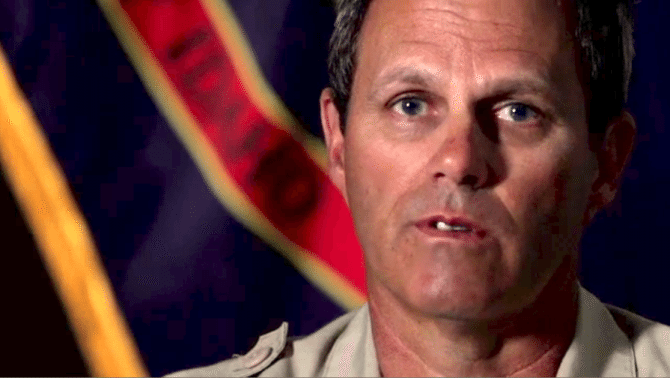

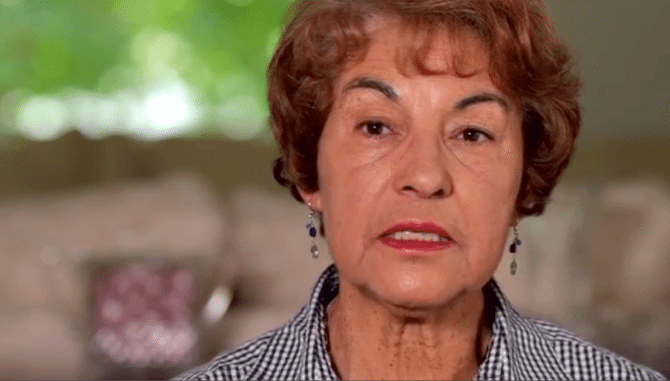
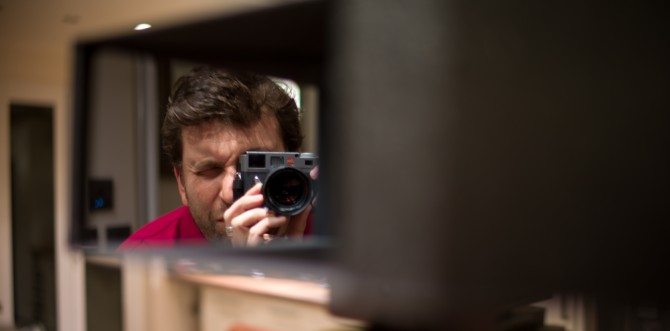
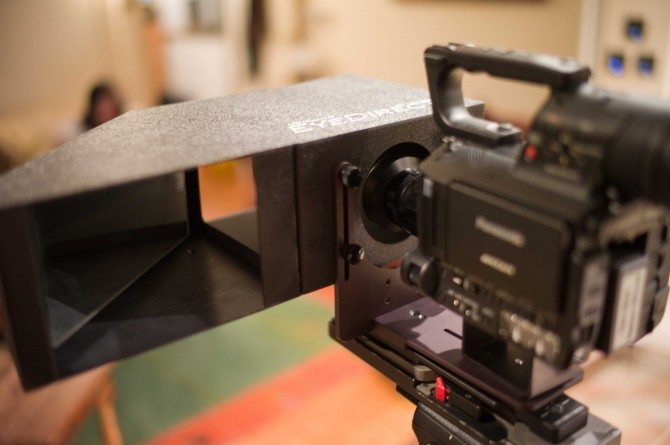
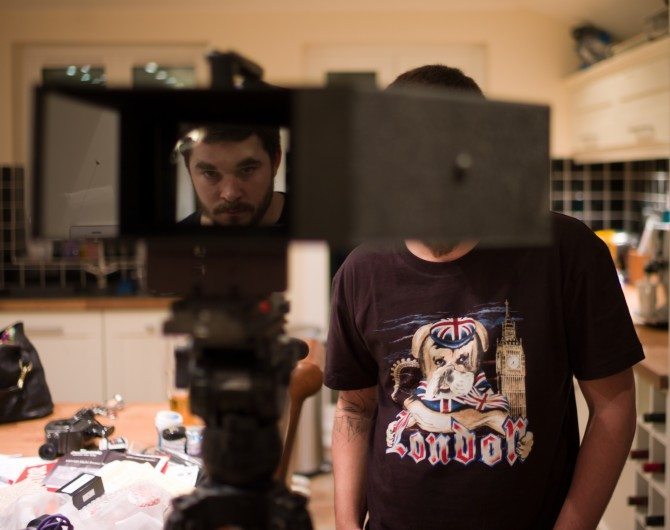
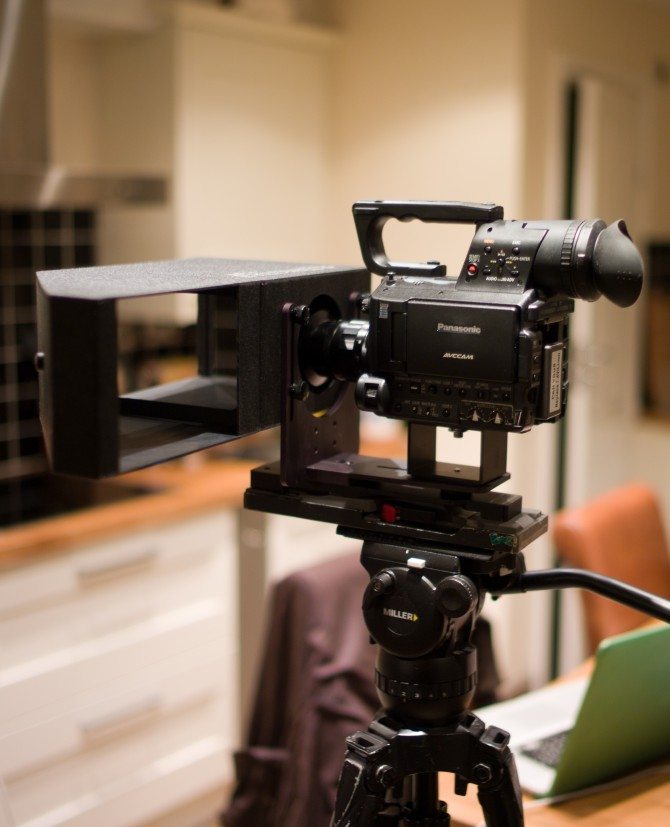

49 comments
That’s interesting. I actually DON’T want my interview subjects looking into the camera, but rather just off camera. In most documentaries I watch that is how it’s done. Curious as to why you have them look into your camera.
because they are talking to you…to the audience…making eye contact with the viewer. It’s more intimate. to make them look off camera i just have myself of interviewer at the eyeline
PB. I have been doing this for a couple of years now. My set up goes like this. I have a 15 inch flatpanel monitor mounted horizontally to a old 15 inch telepromptor frame and glass. I then shoot through the teleprompter glass with my HD camera.
I then have a cheap 1/3 inch color ccd security camera that is pointed @ the producer/director that will be conversing with the on camera talent.
The producer/directors image is fed to the teleprompter set up. This keeps the talents eye’s to always be directed straight into my camera.
I copied this set up from some famous documentary DP. His name escapes me @ the moment.
cheers! he is mentioned in the above blog!
This will work for nothing! [IMG]http://i52.tinypic.com/hunj0l.jpg[/IMG]
That’s interesting. I’ve done interviews both ways and imo they serve two completely different purposes.
Having them look into the camera is much more engaging to the audience. It makes things more personal and intimate for sure…but that’s not always what you want.
Having the interviewee talk to an interviewer and look off camera, to me, feels like a more objective look at what is being said.
I think there is no right or wrong way. It depends on what you’re trying to achieve. I’ve used both styles for different reasons. I once used both styles in the same film for a very specific reason. It all depends.
People do react differently when looking or not looking into the camera. It’s just a different style of shooting I guess.
This is actually a technique by Errol Morris – been in all of his films since his 2nd one on:
http://www.errolmorris.com/content/eyecontact/interrotron.html
The interrotron is WAY better, but obviously not as cheap or simple.
Will def pick one of these up, thanks for the heads up!
RP
Just saw this at $1500…. For me, it’s hard to justify that price when it’s a box with 2 mirrors and a few bolts…..
yep, wish it were cheaper.
Seems to me there is room in the market* for someone to create a cheaper version (and sell more of them).
Anyone?
* Unless the original guy holds a patent on it, of course…
Regarding price, I wonder if this product might be modified to serve dual purposes? It seems to me that a small LCD TV/monitor could be mounted to the photographer’s side of the mirror, and serve as a prompter… or are the optics of the mirror not pure enough to avoid the high-contrast text from bleeding through into the recorded image?
The text size on the prompter might not be that large, but for that “intimate” look which the product is aimed at anyway, it just might work.
yes it can easily be adaptor to a teleprompter
Yeah. Seems like a steep investment just to get people to look into the camera. But, when you’re rolling large like Mr. Bloom here, I’m sure that ain’t nothin’. 🙂 Philip, I bet you could score a free one. Or better yet, get one made with your name on it. 🙂
Yep, This is a blag too far Philip 😉
Hey Ryan, having built a couple of these and an electronic version, its isnt that simple. unfortunately. I too have been looking at these for years and cant quite bring myself to lash out. The front mirror would be a semi silvered or front surface mirror as in a teleprompter, which if good quality is a few hundred bucks in itself. That said im sure a lot of work has gone into designing it. And im sure for best effect and greatest angle of view of the viewer, largest reflection of the interviewer and least unrestricted lens choice im sure the more expensive larger version of the eyedirect would be worth considering too
I worked at an ABC affiliate for a 2 years as a Floor Director and know teleprompters somewhat, and the one way mirrors are very affordable online, most in the 200-300 range.
http://www.telepromptermirrors.com/buyteleprompter.htm
I’ve looked in to building some myself, especially with all the extra 15mm rod parts I have, and I don’t think it’d be too hard or expensive given my resources.
If you don’t know anything about these things, I could see this being a good product for the price.
Side note, for $1500 I could buy a 60D and have a two cam interview shoot…
(I hope I don’t sound as arrogant as when I proof read that! Sorry if so!)
great link thanks ryan. yes semi silvered glass seems to getting cheaper!
you can of course just use one mirror off to the side and have the interviewer stand at 90 degrees too, have done that a bit too but cant beat the simplicity of someone having spent the time to work it all out for you & package it up 🙂
if you are after cheap glass, there is an Australian company called Prompt-It who build a very cost effective Teleprompter based around an iPad. Relevant to your post, they also sell the Beam Splitter glass separately for $65ish. http://prompt-it.com.au/
Worked great forme on this shoot: http://www.youtube.com/watch?v=MVGKl2ES7AE
this is simple and effective!
ingenious stuff!
thanks for submitting!
oren
It really is about style, if you are looking to really grab someone emotionally then in-the-lens is great. I’ve seen it used to film interviews for a PSA for a children’s hospital, and seeing a kid in a hospital bed tell you their story straight in the eye is amazingly powerful. Sometimes the effect is a bit much on long interviews, but it definitely has it’s place.
ESPN aired their last 30 for 30 series documentary last month, and the entire thing was shot on red with an eyeliner, it looked really great.
This thing is so much more practical than an interrotron, it is light weight, packs up easy, requires no electronics, and because of the beamsplitter / mirror design is left to right correct.
My 2 cents.
Almost convinced. Luckily the Euro-Dollar rate is quickly becoming interesting again for us mainlanders 🙂 (@1.37 now…)
I don’t see the benefits of the 16×9 version yet… why should you spend the extra few hundred dollars?
But – what about multi-camera setups during interviews? Would you use the A-camera with the EyeDirect and then set up the B-Camera at a more diverse angle (e.g. capture the subject from the side)?
How does that cut together?
Ok; one more question – when doing multiple interviews, how you quickly change the position of the EyeDirect, so that you can alternate positions of the interviewee (left versus right)?
you wouldnt need to Richard. the eyeline stays the same, always straight at camera so why move the interviewer from one side of camera to other?
But if you were to interview more people consecutively, how would you suggest to cut it together? Use cutaway shots?
I’m guessing that if you have more than one person looking straight into the lens, even if positioned on left-third and right-third, it may look like jump-cuts… Do you have any experience with that?
cuts just fine, if it’s identical framing then sometimes you will need to use filler shots but mostly the frame can vary. just because they are looking at the camera doesn’t mean they all have to be dead centre of frame.
True.
Finally, is it worthwhile to buy the teleprompter monitor, or will your regular monitor work for the same purpose as well? Have you tried PromptDog (http://www.promptdog.com/) software with one of your monitors?
having the eyedirect on wont affect your image. the 16×9 version i was told is great for studio setups but just from my own playing with the cheaper version i cant see an occasion i would need anything but this
what happens when the inevitable look of boredom descends on the operators face.
that will only happen if the operator is asking the questions!
Funny! Yes. Been there. One thing i’ve noticed about the eye direct is that you can assemble it so the interviewer’s mirror is on the right or the left of camera, if you want to go solo then you can easily operate and interview, but you can also flip it over and have an interviewer on the other side of the camera from the operator to handle the questioning… the fake smiling… the head nodding…
exactyly!
Hey Phil and All,
I just had a full blown laugh, I had the same issues a few months ago and I came up with a cheap (relatively) and effective solution. Oddly it came about after I made my own teleprompter… I wasn’t going to pay a lot of money for an lcd and a mirror, so I built one from MDF, a 15″ lcd and two-way glass.
Well the second time I used it, when I plugged in the monitor to my MacBook, the first thing that came up was Skype since I had forgotten to turn it off before I put my MacBook away the night before… my partner saw my face of the the camera lens… and voila moment of epiphany!
Been using it ever since.
So, teleprompter a computer with a webcam and an app to view that web cam… I even saw those mini iphone/ipad teleprompters a few weeks ago… same thing… Skype to the phone.
BTW- the teleprompter cost me $18 to make, much cheaper than $1200.
Wish I could afford one of these.
If the person is speaking to the audience, I like it when they are looking directly at the camera.
If it’s clear that they are supposed to be speaking to the interviewer, then they can look off camera.
For a cheap work around, I use one of these over the lens.
http://digitaldessert.files.wordpress.com/2009/01/1232569660703.jpg
Old trick, often used for commercials. But why so expensive .. ?
hand made in small numbers probably…
I am the inventor of the EyeDirect… and wanted to contribute and answer questions. It has been most interesting reading the post.
To Steve’s point- I’m with you, it is not for every interview. If the interviewer is part of the scene, (i.e. Barbara Walters)… I prefer the off-camera gaze. If Barbara isn’t present, and the interviewee is telling an authentic story, I prefer the camera-aware look. Check out Mystery Diagnosis on Discovery. They have been using the EyeDirect for years.
Using the device in interviews actually puts a disarming ‘buffer’ between the ‘interrogator’ and the ‘victim’. My subjects tend to relax a bit more when I use it, than when I would look at them unobstructed. I just begin my interview with…”look at me”, and the subject ‘gets it’.
QWare, LLC- I have a USB LCD monitor that fits either unit to turn it into a teleprompter…. or as a way to display roller coaster footage to a 7 year old. (An iPad works too.)
Richard van den Boogaard- The little HDV unit that Philip has shown, accommodates monopod and held-held man on the street work. This small HDV EyeDirect can easily be used with adults, but I prefer the larger 16×9 EyeDirect when shooting in the studio or with kids and animals. (Check out Nature’s “The Gorilla King”. The EyeDirect was used in the Rwandan bush to draw the silver back Titus, into the lens). The other really cool thing is, animals acquire the ‘scent’ of their handler, toy… or treat that you are prompting them with. Electronic units can’t do that… yet.
I am a Director/Cameraman, who built this device to solve a need I had. It is my only product and each one is hand-built… with love! Thank you Philip for this wonderful forum to exchange ideas!
When shooting kids, you can also play cartoons or children’s shows through a monitor hooked to the other side and they will give you their undivided attention! Some adults I know as well…
The gentleman who designed the Eyedirect is also a brilliant director, dp, gaffer, and editor. I’ve had the pleasure of editing and scoring a few of his ads.
His motion control work is awesome. Check out some of his work.
http://www.steveshow.com/
No wonder they call him the McGyver of production.
Hmm…a problem completely outside my experience. I find it unnerving when someone looks directly into the camera, unless of course it’s a beautiful woman with a finger resting softly against her lips as she undresses me with her eyes…I’ve learned to live with that.
To what effect would one want an interviewee to look directly into the camera? Other than the aforementioned vixen, all that comes to mind when I think of direct eyeline to iris contact are commercials where someone’s trying to guilt me into giving money or is warning of my impending doom if I don’t give up some treasured vice.
Then again, I’m constantly in awe of how these foreign seeming devices are put to creative use on the other side of the pond. BBC shows get away with the kind of daring artistry that would NEVER be tolerated in the U.S. for fear the audience might be faced with something unfamiliar, which would of course lead to Stravinsky-esque rioting. Don’t be offended my fellow Americans, I’m only accusing the networks of being chickensh*t. I think we could handle it.
Still, I’m not sure I’m keen on the “eyedirect” style. I can’t help wanting to get into a staring contest with the guys from those first couple screen grabs and threatening a raucous brawl unless they get out of my living room and put that fourth wall back up before they leave.
back in 1987 I spent time in India with Salman Rushdie working on a feature length doc called “The Riddle of Midnight’ for C4. It was basically a series of interviews with a cross section of India’s people who were born in 1948. The director Geoff Dunlop wanted to use this effect so we had something made up out of bits of wood, metal and of course mirrors, had a flight case made for it and dragged it around for 5 weeks, shooting a couple of interviews a day. The effect was mesmerising. India’s rich, middle class, poor and dirt poor all telling their stories direct to camera gave the film so much weight. To me there is a sincerity that comes across to the viewer when this kind of tool is used.
One interviewee was a right wing politician who having his buttons pushed by the director during the interview was jabbing his finger at the mirror whilst getting his point over. The result looked like he was jumping out of the screen.
i’m surprised this technique isn’t used more these days. especially when so many current ‘documentaries’ are just talking head shows cut with archive or ‘B roll’. When a talking head is looking camera left or right the audience rarely knows who the person is addressing. Rarely do we hear the questions. To me it’s logical that they would address the viewer.
I just completed a series of TV spots using this technique. I did it by hanging a teleprompter glass via c-stands in front of the camera, wrap a black cloth around the edge of the class and around the matte box.
Angle the glass and seat the interviewer off to the side of the interviewee. Put a small light on the interviewer. They will see each others reflection in the glass and can talk as though the interviewer IS the camera. You can put a divider between the two people if you want to separate them from one another even more.
Works great, easy to set up and very inexpensive. Also, you can move the camera and pan up and down behind the glass without moving the glass. You can then vary your shots much ore than just zooming in and out.
I was shooting a series of interviews for this years Super Bowl and expected the interviews to be directed just off camera. At the last minute the client asked those being interviewed to look directly in to the camera. I scrambled to reset my lighting and kept my finger pointed at the lens to try and maintain eye contact. This device would have made all the difference and made the process less stressful on those interviewed. The cost seems reasonable enough. If you can pack it and ship it and have it arrive intact it’s worth every penny. You do get what you pay for. Right?
Philip – thanks for posting this piece. Prompted by your article, I used the Eyedirect on a series of spots I just did that involved 15 kids, some as young as 5, talking to the camera.
Compared to the video camera/teleprompter approach, it was faster to set up and operate, and less expensive to rent (appreciated by my producer).
The downside for a director is that you don’t see exactly what the camera is recording (most significant in terms of framing). Wasn’t an issue on these spots, but like any tool, the right one depends on the job.
Many thanks.
Wow wonderful stuff. The film about the eating disorder blew me away… I didnt notice that they were both talking to camera a lot until after. Excellent story telling, great technique.
I figure you’d be shooting interviews around 50 or 85 mm but I’m just curious what the maximum angle of view would be when the camera looks through this.